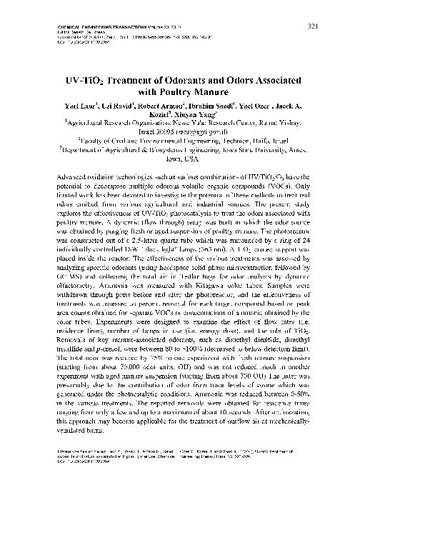
Advanced oxidation technologies such as various combinations of UV/TiO(2)/O(3) have the potential to decompose multiple odorous volatile organic compounds (VOCs). Only limited work has been devoted to investigate the potential of these methods to treat real odors emitted from various agricultural and industrial sources. The present study explores the effectiveness of UV/TiO(2) photocatalysis to treat the odors associated with poultry manure. A dynamic (flow-through) setup was built in which the odor source was obtained by purging fresh or aged suspension of poultry manure. The photoreactor was constructed out of a 2.5-liters quartz tube which was surrounded by a ring of 24 individually controlled 18W "black light" lamps (365 nm). A TiO(2)-coated support was placed inside the reactor. The effectiveness of the various treatments was assessed by analyzing specific odorants (using headspace solid phase microextraction followed by GC-MS) and collecting the total air in Tedlar bags for odor analysis by dynamic olfactometry. Ammonia was measured with Kitagawa color tubes. Samples were withdrawn through ports before and after the photoreactor, and the effectiveness of treatments was assessed as percent removal for each target compound based on peak area counts obtained for separate VOCs or concentrations of ammonia obtained by the color tubes. Experiments were designed to examine the effect of flow rates (i.e. residence time), number of lamps in use (i.e. energy dose), and the role of TiO(2). Removals of key manure-associated odorants, such as dimethyl disulfide, dimethyl trisulfide and p-cresol, were between 80 to similar to 100% (decreased to below detection limit). The total odor was reduced by 75% in one experiment with fresh manure suspension (starting from about 70,000 odour units, OU) and was not reduced much in another experiment with aged manure suspension (starting from about 700 OU) The latter was presumably due to the contribution of odor from trace levels of ozone which was generated under the photocatalytic conditions. Ammonia was reduced between 0-50% in the various treatments. The reported removals were obtained for residence times ranging from only a few and up to a maximum of about 10 seconds. After optimization, this approach may become applicable for the treatment of outflow air at mechanically-ventilated barns.
Available at: http://works.bepress.com/jacek_koziel/367/

This article is published as Laor, Y., U. Ravid, R. Armon, I. Saadi, Y. Ozer, J.A. Koziel, and X. Yang. "UV-TiO2 treatment of odorants and odors associated with poultry manure." Chemical Engineering Transactions, 23, no. 10 (2010): 321-326. DOI: 10.3303/CET1023054. Posted with permission.